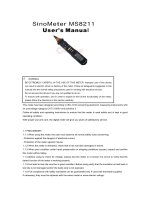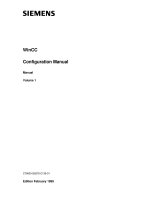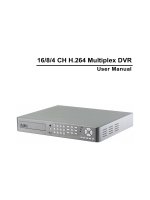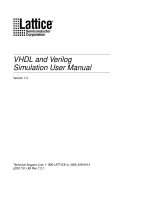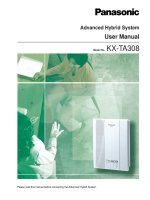User manual coagulyzer 1 GB v1 1
Bạn đang xem bản rút gọn của tài liệu. Xem và tải ngay bản đầy đủ của tài liệu tại đây (1.09 MB, 50 trang )
User Manual
®
Coagulyzer 1
For in-vitro diagnostic use only!
Liability Disclaimer
Analyticon Biotechnologies AG makes no express or implied warranty regarding this manual, its quality,
performance, or appropriate use regarding any type of specific procedure. Furthermore, this manual may be
modified by Analyticon Biotechnologies AG without notice and without implying any obligation or liability on
the part of the company.
Software Copyrights
All software for the Coagulyzer 1 (in the following Analyzer-Software) is the user and instrument control
Software for the Coagulyzer 1 and is the intellectual property of the initial manufacturer. Intellectual property
rights shall remain with the initial manufacturer. Analyticon Biotechnologies AG is entitled to use the
Analyzer-Software and the printed accompanying material. Any violation of property rights or copyright or
trademark or using conditions may be subject to legal action. The initial manufacturer reserves the rights to
modify the software, hardware and documentation without any prior written notice.
Intellectual Property
Analyticon Biotechnologies AG Coagulyzer 1 is registered trademark of Analyticon Biotechnologies AG.
No part of this publication may be reproduced, transmitted, transcribed, stored in a retrieval system, or
translation into any language (human or computer) in any form, or by any means whatsoever, without the
prior written permission of Analyticon Biotechnologies AG in behalf of the initial manufacturer.
Any reference to products, documentation, articles within this publication not expressly described as property
of the initial manufacturer and Analyticon Biotechnologies AG shall be considered as intellectual property of
the publishing company of this certain product, documentation and or article.
Revision History
Version Manual
Date
(mm/dd/yy)
Analyser
Software-Version Release -
1.0
03/23/11
V2.14
1.1
08/25/11
V2.14
Analyticon Biotechnologies AG
Am Mühlenberg 10
35104 Lichtenfels
Germany
Initial version
CONTENTS
TABLE OF CONTENTS
1
INTRODUCTION ....................................................................................... 2
1.1
1.2
1.3
1.4
Application ............................................................................................................... 2
Instrument Description ............................................................................................ 2
Hazard and Precautions .......................................................................................... 5
Standard Symbols ................................................................................................... 7
2
INSTALLATION ........................................................................................ 8
2.1
2.2
2.3
Connect an external printer ..................................................................................... 8
Measuring Principle ................................................................................................. 9
Reagents ............................................................................................................... 10
3
SOFTWARE ............................................................................................ 11
3.1
3.2
3.3
Software overview ................................................................................................. 12
Flow Chart of different application methods .......................................................... 13
Method Parameters ............................................................................................... 14
4
OPERATION ........................................................................................... 15
4.1
Steps for Instrument Operation ............................................................................. 15
4.1.1
4.1.2
4.1.3
4.1.4
4.2
Turn on analyser................................................................................................... 15
STANDBY ............................................................................................................ 16
How to measure ................................................................................................... 17
How to change methods ....................................................................................... 19
Method Parameterization ...................................................................................... 20
4.2.1
4.2.2
4.2.3
4.2.4
4.2.5
4.2.6
4.2.7
4.2.8
PT-parameterization ............................................................................................. 20
aPTT - parameterization ....................................................................................... 25
Fibrinogen G [g/l] - parameterization .................................................................... 28
Fibrinogen MG [mg/dl] - parameterization ............................................................ 31
Thrombin time parameterization ........................................................................... 31
Intrinsic Factor parameterization .......................................................................... 31
Extrinsic Factor – parameterization ...................................................................... 31
Utilities .................................................................................................................. 32
4.2.8.1 Menu printer ....................................................................................... 32
4.2.8.2 Menu computer ................................................................................... 33
4.2.8.3 Menu beeper ...................................................................................... 33
4.2.8.4 Menu clock ......................................................................................... 33
4.2.8.5 Menu calibrate temp ........................................................................... 34
4.2.8.6 Menu secret number ........................................................................... 35
4.2.8.7 Menu cuvette test ............................................................................... 35
4.3
Printer .................................................................................................................... 36
5
SAFETY IN OPERATION........................................................................ 40
5.1
Maintenance and Hygiene..................................................................................... 40
4.3.1 Sample print-outs PT and calibration.................................................................... 37
5.1.1 Disposal of the Analyser ....................................................................................... 40
5.2
Errors ..................................................................................................................... 41
5.2.1
5.2.2
5.2.3
5.2.4
5.2.5
Application errors.................................................................................................. 41
Error Messages .................................................................................................... 42
Errors during operation ......................................................................................... 43
Warnings .............................................................................................................. 43
How to change fuses ............................................................................................ 43
6
APPENDIX .............................................................................................. 44
6.1
6.2
6.3
6.4
6.5
Disposables ........................................................................................................... 44
Materials Supplied ................................................................................................. 44
Technical Data ...................................................................................................... 45
Safety Specifications ............................................................................................. 47
Mathematics .......................................................................................................... 48
Coagulyzer 1 –Operators Manual 1.1
Page 1
INTRODUCTION
1 INTRODUCTION
1.1
Application
The instrument type Coagulyzer 1 (in the following titled as analyser) as
described in this manual is an opto-mechanical coagulation analyser which
applies the turbodensitometric measuring principle.
All routine coagulometric clotting tests such as Prothrombin time, activated
and partial Thromboplastin time, Fibrinogen, and single factor assays can
be performed with these types of instrument.
For in-vitro diagnostic use only!
1.2
Instrument Description
The analyser is constructed in modular units. A liquid crystal display with
one row and 8 characters has been integrated for visual communication.
The arrow keys ◄ / ► allow the operator to select the next step in the
menu. The numbers are for the entry of method parameters.
The Enter key is used to confirm an entry or a selection. The parameter
memory is accessed with the Mode-key. Any procedure can be cancelled or
stopped with the Esc-key.
The measuring channel is integrated into the 37.4°C incubation block with 1
position for reagent bottle and 4 positions for cuvettes.
Immediately after the analyser has been switched on, an adjustment
provides cuvette detection. According to the instructions on the display
cuvette in or cuvette out, place a cuvette into the measuring channel or
remove a cuvette from the measuring channel.
The next step during a run is always shown in the display.
A measurement is automatically started by adding the reagent to a sample
cuvette.
Results can be printed via on optional, external printer or can be read from
the display.
The connector for the external power adapter is located at the back side of
the analyser. The external power adapter can be connected to the mains
with a voltage range from 100V - 240V, 47 - 63Hz.
Via the connection to the main voltage the analyser is automatically
switched on or off.
For data output an RS 232 C 6-pin interface is also located on the back side
of the analyser.
Coagulyzer 1 –Operators Manual 1.1
Page 2
INTRODUCTION
The Analyser
Figure 1
No.
The Analyser
Description
1
Power and printer interfaces in the back
2
Display 1 line, 8 Characters
3
4
Membrane keypad with keys:
Reset, Start, 0 - 9, Mode, Enter, ESC, ◄, ►.
Incubation block 37°C:
- 4 positions for cuvettes
- 1 position for reagent bottle
- 1 measuring channel with light protection cap
Name plate (underneath)
Coagulyzer 1 –Operators Manual 1.1
Page 3
INTRODUCTION
Description of keys
Figure 2
Membrane keypads
Arrow-key left, right
◄ select display to the left
► select display to the right, set decimal point
Esc-key
Switch from measuring to STANDBY
Exit a submenu
Enter-key
Confirm selection, advance printer paper
Number-keys
Enter parameters
0-key
A print-out of the respective parameters for the selected method is
generated by pressing 0 during measuring.
Mode-key
1. Calibration
2. Menu selection, analyser settings, and method
parameterization
3. Exit a menu and save entered or modified data.
Start-key: manual testing
Start sample incubation timer
Sample adjustment
Manual test start
Manual test stop
Reset-Key, reset testing, Break of run, adjustment of sample
Coagulyzer 1 –Operators Manual 1.1
Page 4
INTRODUCTION
1.3
Hazard and Precautions
The caution and safety regulations in this operator’s manual meet
international classification; see also Chapter 1.4 Standard Symbols.
Symbol warns of a risk of injury or of a risk to life (for example by electrical
shock).
Symbol warns of a risk of injury or of the instrument being severely
damaged.
Symbol introduces rules to be observed.
The following caution and safety regulations must be observed at all
times:
1. Electrical safety
Check that the operating voltage is set correctly before you connect the
device to the main power supply.
To connect the device to the power supply, use only sockets which are
grounded in order to keep the risk of an electrical shock as low as possible.
Use only grounded extension cables.
Never remove protective guards or secured components since you
could expose electrically live parts in this way.
Electrical connection contacts (plugs, sockets, etc.) can be electrically live.
Even after a device has been switched off, components (e.g.
capacitators) can be under voltage as the result of an electrical charge.
All current carrying parts are sources of danger for an electrical shock.
Surfaces (floors, work table) must not be moist when you are working with
any electrical device.
Carry out only the maintenance work and/or the replacement of parts
described in these operating instructions.
Unauthorized work on the device can lead to the guarantee obligation
becoming null and void with necessary expensive service work to correct it.
All work which requires the analyser to be opened may only be carried
out by a technician who is familiar with the risks related thereto.
2. Fire and explosion hazards
Do not place any flammable or hazardous explosive material in the
proximity of the analyser.
Coagulyzer 1 –Operators Manual 1.1
Page 5
INTRODUCTION
3. Mechanical safety
(Analyser is operating)
Never open screw-fixed housing parts! There is always the risk of injury.
4. Samples/Reagents
Risk of infections
Avoid any contact between samples and/or test reagents with skin or
mucous membranes and any contact with parts of the instrument that come
into contact with samples/reagents. All consumables, e.g. cuvettes,
reagent vessels, pipette tips that may be used to transfer liquid
samples and reagents should be considered to be potentially infectious. If
specimens are spilled on the system, wipe them off at once and disinfect
the instrument (see Chapter 5.1 Maintenance and Hygiene). Reagents
may cause irritation to the skin and mucous membranes.
Always follow the manufacturer’s instructions for correct use given in
the literature accompanying the reagent.
Dispose of spent samples and waste reagents and all consumables that
have come into contact with them after completion of the measurements
strictly in accordance with statutory directives and laboratory guidelines.
Wear gloves! There is the risk of infection.
5. Accuracy and precision
of the measured results
In order to ensure a flawless operation of the analyser measure control
samples and watch the function of the instrument closely.
Faulty measurement results may result in an incorrect diagnosis or range
danger for patient.
6. Restrictions for samples
and reagents
Resistance of cuvettes to organic solvents cannot be guaranteed. For this
reason, organic solvents should not be used unless they have been
expressly permitted. Only use the original manufacturer’s cuvettes and
mixers! Use cuvettes and mixers once only! Prior of each measurement
ensure a mixer is added to each cuvette.
7. User qualification
The analyser should only be operated by trained personnel. Ask you local
dealer or distributor for further information on the availability of user
trainings.
Coagulyzer 1 –Operators Manual 1.1
Page 6
INTRODUCTION
1.4
Standard Symbols
A large number of symbols are used in this Operator’s Manual, on the
instrument itself, and on available accessories and consumables. Their
meanings are given below:
Manufacturer
Order Number
In Vitro Diagnostic Medical Device
Serial Number
CE Conformity
Protect From Sunlight
Refer to Operators Manual
Recyclable
Biological Risk
Caution
Temperature Limitation
Danger
Humidity Limitation
Important Information
Do Not Reuse
Separate collection, handling and
disposal for waste electrical and
electronic equipment and its
components
Batch Code
Electric Shock Warning
Fuse
Coagulyzer 1 –Operators Manual 1.1
Page 7
INSTALLATION
2 INSTALLATION
Remove the analyser from its packaging and verify that the accessories kit
is complete. Please notify your distributor immediately in the event that the
shipment was incomplete. Refer also to chapter 6.2 Materials Supplied.
Proceed as follows to install the analyser:
• Prior to installation of the analyser read the instructions under chapter 1.3
Hazard and Precautions.
• Place the analyser in a position that it is not exposed to excess humidity,
any explosive gases, or magnetic influences.
• Connect the power adapter between the analyser and a power supply
(100V - 240V) free from interferences by large power users such as
elevators and centrifuges.
• Use only the included original AC power adapter.
• Use only original cuvettes and stir bars which will assure proper operation
of the instrument.
Switch on the analyser
• Connect the external power adapter with the analyser
.
• Connect the external power adapter with the mains; automatically the
analyser is switched on.
Figure 3
2.1
Analyser connections
Connect an external printer
• Connect the data-cable between the analyser and the printer. Ask your
dealer for recommended printer types.
• Connect the power adapter to the printer (see figure 3). The printer will be
set ON by connecting to the mains.
• Refer to chapter 4.2.8.1 Menu printer for proper printer setting.
Never operate the printer without paper! Read the instructions
manual from the manufacturer of the printer for further details.
Coagulyzer 1 –Operators Manual 1.1
Page 8
INSTALLATION
2.2
Measuring Principle
The analyser operates according to the opto-mechanical measuring
principle. This measuring principle is especially suited for lipaemic and/or
icteric coloured samples as well as reagents with kaolin.
A light beam passes through the cuvette containing the test plasma onto a
photo detector. Any change in the intensity of the transmitted light, that is
light increase or decrease, is converted into an electric signal. Hence, even
the most unstable clot can be detected.
The period from adding the start reagent until clot formation is measured. It
then can be converted into the appropriate units (%, ratio, INR, mg/dl, g/l).
Once the start reagent has been added, the measuring channel is adjusted,
that is the lamp intensity automatically adjusts up or down depending on the
turbidity of the test sample. In this process the turbidity of the sample
plasma and the reagent are adjusted.
A mixer is located in the cuvette. During the measuring process the mixer
provides homogeneity of the reagent-plasma medium. At the same time a
small whirl emerges through the mixer movement which assures that even
the smallest fibrin clot is formed in front of the photo detector.
This stirring action combined with the optical measurement constitutes the
basic features of the patented "turbodensitometric measuring principle".
Figure 4 Measuring Principle
Coagulyzer 1 –Operators Manual 1.1
Page 9
INSTALLATION
2.3
Reagents
For proper coagulation analysis we recommend the use of Analyticon
reagents, controls and buffers. Always read the information leaflet in the
pack and observe the instructions given by the reagent manufacturer.
Utilize reagents and controls only according to directions as provided
by the reagent manufacturer to avoid incorrect measuring results or
malfunctions of the analyser.
Contamination
With the application of different reagents, and here especially reagents
containing thrombin, there is a danger of reagent carry-over.
When adding reagents the light protection cap is exposed to
reagents and hence a point of contamination.
If liquid residue or dried-on remnants can be seen on the rim of the opening of
the light protection cap, remove them with laboratory disinfectant solution and
cotton buds.
Other things you may need to or
must take into consideration:
Only use the analyser according to the required ambient conditions.
Protect the measuring channels from direct sunlight or other light
sources.
Only use pipettes which are being validated in regular intervals. Close
the light protection cap prior of each measurement.
Make sure that pipetting does not cause any air bubbles. Use a new
tip after every pipetting operation to prevent reagent/sample carryover.
Always place a cuvette in the measuring tube before pipetting. Ensure
each cuvette is equipped with a mixer. Pipetting reagent or sample
into the measuring tube can significantly contaminate the analyser
and could even render it faulty, so that expensive cleaning or repair
might become necessary.
Only use the original manufacturer’s cuvettes and mixers as they are
subject to strict quality control. The use of other makes of cuvette and
any associated instrument problems as a result, will invalidate your
guarantee.
Use cuvettes once only. Multiple use of cuvettes may produce
incorrect results; this in turn can become an indirect hazard for the
patient.
Perform regular quality control checks. Please refer to the guidelines
of use provided by the reagent manufacturer.
Coagulyzer 1 –Operators Manual 1.1
Page 10
SOFTWARE
3 SOFTWARE
The software for the analyser is stored in a memory and will be activated as
soon as the analyser is switched on. It controls the analyser via start
functions for the analytic program.
Visual communication between the analyser and the user is accomplished
via a liquid crystal display with one row and 8 characters.
The menu Utilities has been integrated into the method menu so that
system settings can be performed for the following menus
<computer>, <beeper>, <clock>, <calibrate temp>, <secret number>, and
<cuvette test>.
The analyser contains automatic cuvette detection. The following display
will appear after initialization:
<-auto blanking
..
keep channels clear.
At this point the optical blank value will be determined and stored for the
measuring channel. No cuvettes may be located in the measuring channels
at this time!
Due to the optical change in the measuring channel, the analyser
automatically recognizes whether a cuvette is placed into the measuring
channel or being removed.
Storing of parameter
After a parameterization of an instrument or test-data, short information
"write parameter" will be shown on the display.
Coagulyzer 1 –Operators Manual 1.1
Page 11
SOFTWARE
3.1
Software overview
Analyser name
Power ON
Initialising
WARM UP
Remove cuvettes
then press any key
auto blanking
keep channels clear
<
Method parameter
1 PT
>
Test steps (double determ.)
Method list
secret no.:
cuv in 1
< 1 PT
< 1. conv >
incu 47
< 2 aPTT >
< 2. conv >
adj – S1
< 3 FibG >
< replic
GO-S1
< 4 FibMG>
< measure >
100 ul
< 5 Thrmb>
< cuvdet
1.2 s
< 6 Intr.>
t= 12.6 s
< 7 Extr.>
cuv out,*
< UTILIT >
>
>
>
cuv in 2
incu 52
secret no.:
adj – S2
GO - S2
< comput >
100 ul
< beeper >
6.9 s
< clock
mean time=
< calib. >
% = 91.0
< sec.no >
INR = 1.05
< cuvet. >
>
>
cuv out, *
* then press “Reset”
Figure 5 Software Overview
Coagulyzer 1 –Operators Manual 1.1
Page 12
SOFTWARE
3.2
Flow Chart of different application methods
Flow chart to set single or double determination at the analyser.
Test steps for
double determination
Test steps for
single determination
cuv in 1
cuv in
incu 47
incu 47
adj – S1
adj – S
GO - S1
GO - S
100 ul
100 ul
1.2 s
1.2 s
t= 12.6 s
time =…
cuv out,*
= 12.6 s
cuv in 2
% = 91.0
incu 52
INR = 1.05
adj – S2
cuv out, *
GO - S2
100 ul
6.9 s
mean time=
% = 91.0
INR = 1.05
cuv out, *
* then press “Reset”
Figure 6
Test procedures for single and double determination
Coagulyzer 1 –Operators Manual 1.1
Page 13
SOFTWARE
3.3
Method Parameters
The following default settings are programmed set by the manufacturer.
Before performing routine tests, the user must change certain reagent
specific parameters such as lot number and calibration curve parameter.
The following parameter settings are manufacturer’s settings.
Program Version:
Printer:
Computer:
Beeper:
Secret no.:
Cuvette detection:
Single determination:
V X.xx Release mm.dd.yy
AUTO
OFF (only for service purposes!)
ON
11111
OFF
for all methods
Method Parameters (factory settings)
method name
max. 5 characters
incub [sec] (0=off)
start-reagent [µl]
1st conversion reference curve
(quick)
1st conversion unit
decimal place
2nd conversion (INR/RATIO)
min value (conc)
max value (conc)
time (lin / log / rezi)
value (lin / log / rezi)
method store
1
2
3
4
5
6
7
PT
aPTT
FibG
FibMG
Thrmb
Intr.
Extr.
60
120
60
60
60
120
60
100
50
50
50
100
50
100
curve
curve
curve
curve
curve
%
1
0
2
0
1
1
1
INR
Ratio
-
5
0
0.2
20
0
0.5
0.5
150
0
10.0
1000
0
200
200
lin
lin
log
log
lin
log
log
rezi
lin
log
log
lin
log
log
g/l
mg/dl
%
%
Coagulyzer 1 –Operators Manual 1.1
Page 14
OPERATION
4 OPERATION
4.1
4.1.1
Steps for Instrument Operation
Communication with the analyser is performed via the liquid crystal display.
We assume that you are familiar with the function of the individual keys as
described in chapter 1.2 Instrument Description
Turn on analyser
• Connect the analyser power adapter to the mains, automatically it is
switched on.
The following text will appear in the display:
This sign <- informs of a floating text.
<- read param.
..
analyser name V X.xx (C)mm/dd/yy
Analyticon
Manufacturer
SELFTEST
Self test
ROM: ok
Testing of ROM
RAM: ok
Testing of RAM
WARM UP
Start of warning up
The changing display will show the
36.5oC
- actual temperature of the measuring block
14:26
- the remaining time of warm up phase.
The analyser requires approximately 30 minutes to warm up the incubation
block to an operating temperature of 37.4°C (deg).
Use the warm-up phase to load the analyser with cuvettes and reagents for
testing.
Each cuvette must be equipped with a stir bar.
• Comply with the instructions of the reagent manufacturer.
• Compare the method parameters with those stored in the analyser.
• For your own safety follow instructions for hygiene.
As soon as the operating temperature has been reached, an adjustment for
automatic cuvette recognition will follow.
<- Remove cuv
..
.ette, then press any key.
• Remove the existing cuvette from the measuring channel and close the
light protection caps.
• Press any key (e.g. Enter) for confirmation.
Coagulyzer 1 –Operators Manual 1.1
Page 15
OPERATION
<-auto blanking
..
keep channels clear.
The measuring channel will be adjusted for automatic cuvette detection.
(Time requirement: approximately 10 seconds).
No cuvettes must be in the measuring channels when saving the
blank values. Otherwise a wrong value is saved which might lead
to evaluation problems. Protect against external light as this might
have an impact on the blank value as well.
The method used last e.g. PT is selected.
<
1 PT
>
Printer
If the printer is set to AUTO in the menu UTILITIES the parameterization of
the selected method as well as the result of the first measurement is printed
as soon as the first measurement is completed.
Additional results will be printed automatically upon completion of a
measurement.
4.1.2
STANDBY
<
1 PT
>
The selected method will be displayed.
• Press Enter to access the measuring mode.
• Press Esc to return to STANDBY.
A request for sample incubation will be displayed.
cuv in
If there is no action the next 10 minutes, automatically the display will
change to the STANDBY mode and show the actual temperature.
37.4°C
Coagulyzer 1 –Operators Manual 1.1
Page 16
OPERATION
4.1.3
How to measure
One measuring channel is available for measuring.
The following description refers to a double determination of PT. The test
procedure varies depending on single or double determination. For
additional information, please refer to chapter 3.2 Flow Chart of different
application methods.
Single/double determinations
The user can switch to single determination prior to or after a measurement
in the method menu <replication>, refer to chapter 4.2.1 PTparameterization.
Sample incubation
Sample incubation is always performed in the measuring channel!
• Switch to measuring mode.
cuv in 1
• Open the light protection cap.
• Pipette 50 µl citrate plasma in a cuvette.
• Immediately place this cuvette into measuring channel.
• Close the light protection cap.
The analyser automatically recognizes the cuvette and starts the timer for
sample incubation (timer countdown). An acoustic signal indicates 5 sec
remaining incubation time.
incu
47
Timer count down
After sample incubation the measuring channel will be adjusted for sample.
(adjS = adjust Sample).
adj – S1
Sample adjustment
Once the sample has been adjusted the following display 100 ul alternately
GO – S1 appears:
100
ul
GO – S1
Request to add
add start reagent
• Aspirate 100 µl start reagent into the pipettor.
• Place the pipette vertically onto the light protection cap.
• The measurement is automatically started by pipetting the start reagent
into the sample cuvette.
1.2
s
current measurement in [sec]
An acoustic signal indicates the recognition of clotting in a measuring
channel and stops the timer.
t = 12.6 s
clot recognition in [sec]
Coagulyzer 1 –Operators Manual 1.1
Page 17
OPERATION
<-cuv out, then
..
press „Reset“
• Open the light protection cap.
• Remove cuvette out of the measuring channel.
• Press Reset-key.
cuv in 2
• Pipette 50 µl citrate plasma in a cuvette.
• Immediately place this cuvette into measuring channel.
• Close the light protection cap.
The analyser automatically recognizes the cuvette and starts the timer for
sample incubation (timer countdown). An acoustic signal indicates 5 sec
remaining incubation time.
incu
52
Timer count down
After sample incubation the measuring channel will be adjusted for sample.
(adjS = adjust Sample).
adj – S2
Sample adjustment
Once the sample has been adjusted the following display 100 ul alternately
GO – S2 appears:
100
ul
Request to add
GO – S1
add start reagent
• Aspirate 100 µl start reagent into the pipettor.
• Place the pipette vertically onto the light protection cap.
• The measurement is automatically started by pipetting the start reagent
into the sample cuvette.
6.9
s
current measurement in [sec]
An acoustic signal indicates the recognition of clotting in a measuring
channel and stops the timer.
<- mean time =
..
12.2 s
clot recognition in [sec]
Once the second measured value has been obtained, the mean from the
measured values will be determined and converted into %, ratio, and INR
via the entered calibration curve.
Coagulyzer 1 –Operators Manual 1.1
Page 18
OPERATION
The results will be displayed consecutively for duration of 5 sec. The printer
will automatically print the results. The last message cuv out then press
"Reset" will request the removal of the cuvettes from the measuring
channels.
<- mean time =
..
12.4s Display of mean value in [sec.]
% = 91.0
Display of activity in [%]
INR = 1.05
Display of INR
If ratio is selected under 2nd conversion, ratio will be displayed instead of
INR.
<-cuv out, then
..
press „Reset“
• Open the light protection cap.
• Remove cuvette from measuring channel and confirm by pressing Resetkey (see chapter 3 Software).
The analyser is now ready for additional measurements.
cuv in 1
Continue as described for additional measurements.
The timer can be started or stopped manually by pressing the
Start-key.
Refer to function keys in chapter 1.2 Instrument Description.
4.1.4
How to change methods
Methods can only be changed from STANDBY.
<
1 PT
>
STANDBY
• Press Esc to switch to STANDBY.
• Press the right arrow; the next method aPTT is displayed as ready-tomeasure.
• By repeatedly pressing the arrow-key ► (arrow-key ◄ back) the following
methods and the UTILITIES Menu will be displayed one after the other:
<
<
<
<
<
<
<
<
1 PT
2 aPTT
3 FibG
4 FibMG
5 Thrmb
6 Intr.
7 Extr.
UTILIT
>
>
>
>
>
>
>
>
g/l
mg/dl
Coagulyzer 1 –Operators Manual 1.1
Page 19
OPERATION
• Select the desired method (1-7).
• Press Enter to confirm the method selection.
The new method has been initialized. Incubation of the first samples can
begin.
cuv in 1
Continue as described for PT in chapter 4.1.3.
UTILITIES
The menu Utilities is a group of menus in which instrument settings can be
performed after a "Secret no." (code number) has been entered.
The submenus are as follows:
<calibrate temp>, <secret number>, and <cuvette detect.>.
Refer to chapter 4.2.8 Utilities.
4.2
4.2.1
Method Parameterization
PT-parameterization
Method parameters in the analyser have been preset by the manufacturer.
Prior to performing clotting analysis you must update the method parameter
for the reagent used.
• Set analyser to STANDBY mode
<
1 PT
>
STANDBY
• Press Mode. The analyser will request you to enter an up to 5 digit long
secret number (factory setting: 11111). For additional information refer to
chapter 4.2.8.6 Menu secret number.
<- secret no.:
..
_________
If the wrong number was entered STANDBY will be displayed. As soon as
the correct number has been entered, the following display will appear:
<1.conv>
Press the arrow key ► to display the following menus: <1. conversion>,
<2. conversion>, <replication>, <measurement> and
Overview PT parameterization:
<1.conversion>
<curve>
<quick>
<none>
<2.conversion>
<INR>
<ratio>
<none>
input of a 9-point calibration curve under or
to enter the 100%-value and slope or
for no conversion
input of the ISI-value for INR or
input of normal value for ratio calculation or
for no conversion
Coagulyzer 1 –Operators Manual 1.1
Page 20
OPERATION
<replication>
<single>
<double>
select single or double determination
and the coefficient of variation
(CV 1-20%).
<measurement>
start reagent volume, reagent lot. no.
and sample incubation time.
<cuv remove detect.>
<ON>
<OFF>
refer to chapter 3 Software
activates the automatic cuvette detection
deactivates the automatic cuvette detection.
(default)
Enter a calibration curve
1st conversion
curve
• Select 1. conversion and press Enter to confirm selection.
< curve >
A 9-point calibration curve can be entered with this menu.
Calibration curve points that are not to be used must have the entry 0.0 s.
For information of interpolation refer to chapter 6.5 Mathematics. The
system requires two points to be defined but we would recommend a
minimum of 3 points. You can exit the calibration curve menu with Esc if no
entry has been made. Once an entry has been made, all additional
calibration curve points must be retrieved and verified.
• Press Enter to type in the first calibration point. This point is defined as
point of greatest activity and shortest clotting time.
1.point
100.0 %
• Confirm the activity of 100.0 % by pressing Enter or overwrite the preset
entries by pressing the respective number keys. Confirm your entry with
Enter. The cursor switches to the time setting.
12.0 s
• Enter the clotting time for the respective activity of 100.0 %.
• Press Enter to confirm your entry.
The entry field for the next calibration curve point is displayed.
2.point
• Verify or update the second calibration curve point as described above.
• To enter additional calibration curve points follow the above instructions.
Coagulyzer 1 –Operators Manual 1.1
Page 21
OPERATION
The following display appears once the last calibration curve point has been
confirmed:
<- select: ESC.
..
= work ENTER= more parameters
• Press Esc to access the measuring mode or Enter to add or verify
additional parameters.
Quick
The curve for the PT calibration curve can be entered by typing in the 100
%-value and the factor for the slope of the calibration curve.
< quick >
• Press Enter to confirm selection.
<- 100 %
Example!
= 11.6 s
normal clotting time
factor = 54
Please use the value for factor as provided with the reagent package insert.
If you need to calculate the factor by yourself, please refer to chapter 6.5
Mathematics.
If complete data has been entered for <curve> and <quick > the
calibration curve type selected last is active for conversions in the
ready-to-measure mode. This is also valid for INR and ratio under
2nd conversion.
• Press Esc to access the measuring mode or Enter to add or verify
additional parameters.
none
If < none > was selected no conversion will be performed.
2nd conversion
< 2.conv >
If a calibration curve has been entered in menu 1st conversion or if <none>
has been selected, the 2nd conversion can be used for INR or ratio.
INR
• Press Enter and the following display appears:
< INR >
• Press Enter to type in the ISI-value.
ISI= 1.05
Coagulyzer 1 –Operators Manual 1.1
Page 22
OPERATION
ATTENTION: If <none> was selected under 1st conversion the 100 % sec
value, e.g. 100 % = 12, 6 sec. will be requested.
• Enter the ISI-value provided on the reagent package insert.
• Press Enter to confirm the entry.
<- select: ESC.
..
= work ENTER= more parameters
• Press Esc to access the measuring mode or Enter to add or verify
additional parameters.
ratio
< ratio >
• Press Enter to confirm the entry.
100% = 12.0 s
Input of normal time for the 100 % value
• Press Enter to confirm the entry.
<- select: ESC.
..
= work ENTER= more parameters
• Press Esc to access the measuring mode or Enter to add or verify
additional parameters.
none
If < none > was selected no conversion will be performed.
replication
In the menu "replication“, you can select between "double" for double
determinations or "single" for single determinations by pressing the arrow
key.
< replic >
• Press Enter.
< double >
Selection of double determination
• Press Enter to confirm the selection
Only if double determination has been selected the following display for
entry of the coefficient of variation of the individual values will be displayed.
If this value is exceeded the message "mean error" will appear in the display
and print-out.
<-coef variatio
n
= 10% possible entry range: 1% - 20%
• Enter the coefficient of variation
• Press Enter to confirm the entry.
Coagulyzer 1 –Operators Manual 1.1
Page 23
